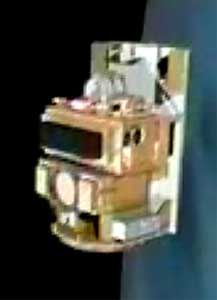
Home - Search - Browse - Alphabetic Index: 0- 1- 2- 3- 4- 5- 6- 7- 8- 9
A- B- C- D- E- F- G- H- I- J- K- L- M- N- O- P- Q- R- S- T- U- V- W- X- Y- Z
TERRIERS
 TERRIERS Credit: Manufacturer Image |
AKA: Tomographic Experiment / Radiative Recombinative Ionospheric EUV & Radio Sources. Status: Operational 1999. First Launch: 1999-05-18. Last Launch: 1999-05-18. Number: 1 . Gross mass: 125 kg (275 lb).
Using a combination of ground based and space instruments, TERRIERS surveyed the upper atmosphere using a technique called tomography, measuring ultraviolet light emissions, to construct an image of Earth's ionosphere.
While the ionosphere had been studied in detail in the past, at the time of TERRIERS' launch there were no means to obtain global three dimensional maps of electron density. Such measurements were of crucial importance in understanding many upper atmosphere phenomena. As secondary goals, TERRIERS examines related upper atmospheric phenomena, and tested the utility of long term solar irradiance measurements.
The spacecraft spun at 3 rpm in "Thompson Spinner" configuration. Attitude and spin rate control was via 3 magnetic torque coils. Attitude determination was by sun sensors, magnetometers and horizon crossing indicators. The satellite used 16W of orbit-averaged power and could downlink telemetry at 250 kbit/s in S-band. The spacecraft bus was based on, though not an exact copy of AeroAstro's HETE design.
Primary payload was 5 imaging spectrometers, 4 of which operated in the night portion of the orbit. TERRIERS also carried 2 photometers, and a Gas Ionization Solar Spectral MOnitor (GISSMO) which was an optics-free solar EUV spectrometer. Riding piggyback at the base of the spacecraft bus was a small payload built by Cleveland Heights High School.
NASA NSSDC Master Catalog Description
The Tomographic Experiment using Radiative Recombinative Ionospheric EUV and Radio Sources (TERRIERS) project is the second satellite in NASA's Student Explorer Demonstration Initiative (STEDI) program. STEDI, managed for NASA by USRA, is a pilot program to demonstrate that high-quality space science can be carried out with small, low-cost (<$4.4 Million) free-flying satellites on a time scale of two years from go-ahead to launch.
TERRIERS is a collaboration between the Center for Space Physics at Boston University, AeroAstro Inc. (satellite and ground station), the University of Illinois at Urbana-Champain, the Naval Research Laboratory, MIT's Haystack Observatory, Phillips Laboratory and Cleveland Heights High School. TERRIERS' primary goal is to demonstrate meridional 2-D (latitude-altitude) and global 3D imaging of the ionospheric electron density and thermospheric photo-emission profiles using EUV emissions and tomographic techniques. A secondary goal is the study of several ionospheric and thermospheric phenomena and a tertiary goal is to test the utility of a new technique for long term solar EUV irradiance measurements (GISSMO).
The TERRIERS spacecraft is based on the High energy transient Experiment (HETE) spacecraft. The spacecraft is highly autonomous. After initial orbit insertion, it will place itself in the safe orbital configuration and contact the ground station to begin mission operation. Science operations will be conducted from Boston University through a single ground station.
Instrumentation consists of five Tomographic EUV spectrographs (TESS) for nightglow and dayglow observations (80-140 nm,1-2 nm resolution), the Gas Ionization Solar Spectral Monitor (GISSMO) measuring solar EUV with high sensitivity over long time periods, two photometers for 630 nm night airglow, a dual-frequency radio beacon for electron content measurements.
Note added November 16, 1999: Due to attitude control problems further detailed in the Boston University TERRIERS web page, the spacecraft battery power was quickly expended and no good data have been acquired. As of this writing, recovery efforts continue.
More at: TERRIERS.
Family: Earth, Ionosphere sat, Sun synchronous orbit, Technology. Country: USA. Launch Vehicles: Pegasus, Pegasus XL, Pegasus XL/HAPS. Launch Sites: Point Arguello WADZ. Agency: AeroAstro, Boston. Bibliography: 2, 6, 13271.
1999 May 18 - . 05:09 GMT - . Launch Site: Point Arguello. Launch Complex: Point Arguello WADZ. Launch Pad: Aircraft from Vandenberg.. Launch Platform: L-1011. LV Family: Pegasus. Launch Vehicle: Pegasus XL/HAPS.
- TERRIERS - .
Nation: USA.
Agency: NASA Greenbelt.
Manufacturer: AeroAstro.
Class: Technology.
Type: Military technology satellite. Spacecraft Bus: HETE.
Spacecraft: TERRIERS.
USAF Sat Cat: 25735 . COSPAR: 1999-026A. Apogee: 493 km (306 mi). Perigee: 484 km (300 mi). Inclination: 97.10 deg. Period: 94.40 min.
TERRIERS was part of NASA's Student Explorer Demonstration Initiative (STEDI), which was a precursor program to the UNEX (University Explorer) series. STEDI was managed by USRA (the Universities Space Research Association) for NASA, while UNEX was to be more directly managed by NASA-GSFC. TERRIERS was to be operated by the space physics group at Boston University for ionosphere studies, and carried TESS, a set of extreme ultraviolet (EUV) spectrographs to get electron density and thermosphere emission profiles. The GISSMO instrument measured the solar EUV flux. The spacecraft was built by AeroAstro and based on HETE. TERRIERS was placed in the correct orbit, but it failed to orient its solar panel to the Sun and ran out of battery power by May 20. Controllers were optimistic that when its orbit processes to a better sun angle the satellite could be revived. Air dropped in Point Arguello WADZ. Additional Details: here....
Back to top of page
Home - Search - Browse - Alphabetic Index: 0- 1- 2- 3- 4- 5- 6- 7- 8- 9
A- B- C- D- E- F- G- H- I- J- K- L- M- N- O- P- Q- R- S- T- U- V- W- X- Y- Z
© 1997-2019 Mark Wade - Contact
© / Conditions for Use